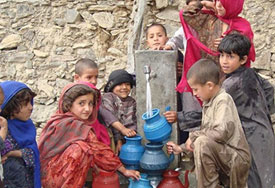Assessment and Analysis of Rural Water Supply Problem, Kandahar Province, Afghanistan

Assessment and Analysis of Rural Water Supply Problem including GIS Mapping & Community Training in Kandahar Province of Afghanistan
It was ever first systematic and detailed study on assessment of existing rural water supply problem in Afghanistan which has a population of 2.2 crores. The study was conducted for Kandahar Province of Afghanistan. Only 13% of the people have access to potable water sources and the situation has worsened due to inadequate rainfall over last few years. In particular Kandahar province is badly affected since rainfall and snowfall have both been minimal. Water levels of the river Arghandab- the main water source for Kandahar have dropped. This has resulted in damaging shallow and the traditional KAREZ (underground water sources). Local people do not have access to sufficient water.
The consultancy included-
- To consult local communities & district authorities and to field survey the existing water sources for drinking water supply.
- Testing of water samples of all the borewells
- Identify & suggest borewells (shallow water wells) with hand pumps in communities to increase access to water.
- GIS mapping of all villages and water sources in the project area.
- Conduct training courses for local communities on maintaining the wells in the future & awareness for sanitary conditions.
Consultant was given task of complete study, evaluation of problem & remedial measures and preparation of action plan to establish safe & potable water & GIS mapping of sources and estimation of funds required which is detailed out as under – Survey, Water Testing and Consultation With Local Communities: Consultant groups conducted physical survey of each & every well in the project area and consulted local communities & district authorities. This also included testing of water samples from these wells. The tests were conducted using field water testing Kits. The parameters included pH, Total Dissolved Solids, Chlorides, Fluorides, Iron and Nitrates. The data so collected was also verified with those already available in District or Regional offices. The job included development of formate for each district showing each and every activity.
Identification of Sources: This job included identification and suggestion of borewells (shallow water wells) with hand pumps in these communities to enhance the water supply level to these villages. A safe & potable water source was sought out for every 120 persons. The suggestion of source was made such that at least 40 lpcd water is available to each person.
